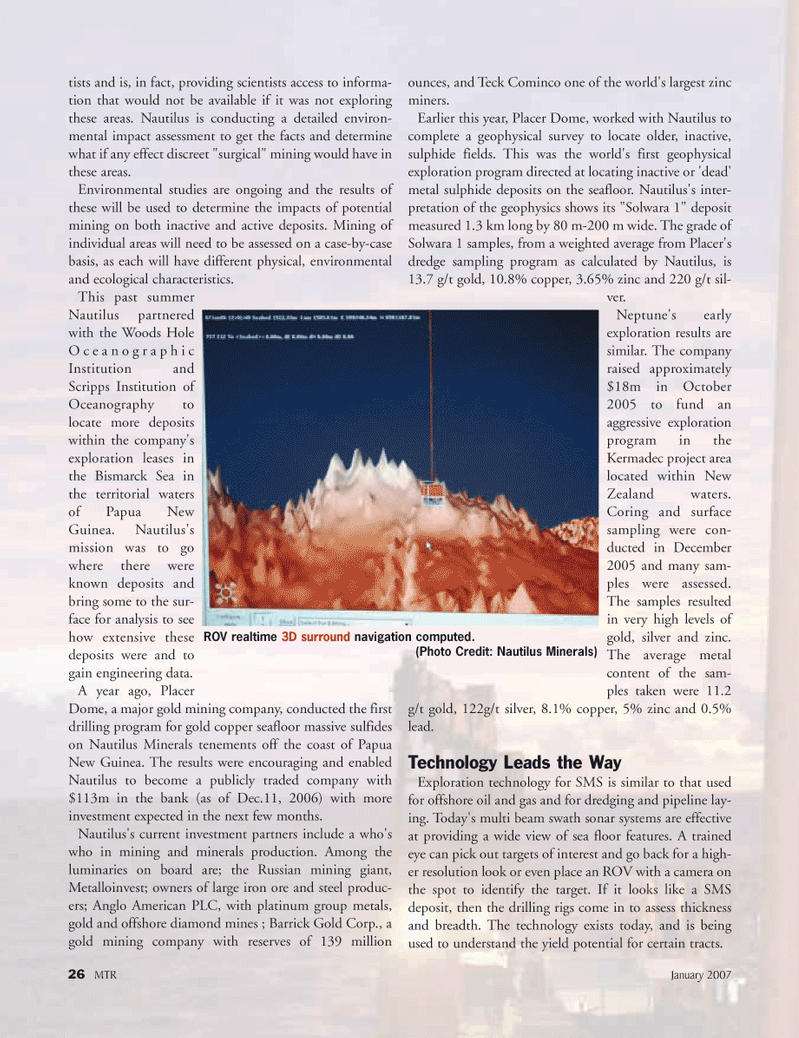
Page 26: of Marine Technology Magazine (January 2007)
Seafloor Engineering
Read this page in Pdf, Flash or Html5 edition of January 2007 Marine Technology Magazine
26 MTR January 2007 tists and is, in fact, providing scientists access to informa- tion that would not be available if it was not exploring these areas. Nautilus is conducting a detailed environ- mental impact assessment to get the facts and determine what if any effect discreet "surgical" mining would have in these areas.
Environmental studies are ongoing and the results of these will be used to determine the impacts of potential mining on both inactive and active deposits. Mining of individual areas will need to be assessed on a case-by-case basis, as each will have different physical, environmental and ecological characteristics.
This past summer
Nautilus partnered with the Woods Hole
Oceanographic
Institution and
Scripps Institution of
Oceanography to locate more deposits within the company's exploration leases in the Bismarck Sea in the territorial waters of Papua New
Guinea. Nautilus's mission was to go where there were known deposits and bring some to the sur- face for analysis to see how extensive these deposits were and to gain engineering data.
A year ago, Placer
Dome, a major gold mining company, conducted the first drilling program for gold copper seafloor massive sulfides on Nautilus Minerals tenements off the coast of Papua
New Guinea. The results were encouraging and enabled
Nautilus to become a publicly traded company with $113m in the bank (as of Dec.11, 2006) with more investment expected in the next few months.
Nautilus's current investment partners include a who's who in mining and minerals production. Among the luminaries on board are; the Russian mining giant,
Metalloinvest; owners of large iron ore and steel produc- ers; Anglo American PLC, with platinum group metals, gold and offshore diamond mines ; Barrick Gold Corp., a gold mining company with reserves of 139 million ounces, and Teck Cominco one of the world's largest zinc miners.
Earlier this year, Placer Dome, worked with Nautilus to complete a geophysical survey to locate older, inactive, sulphide fields. This was the world's first geophysical exploration program directed at locating inactive or 'dead' metal sulphide deposits on the seafloor. Nautilus's inter- pretation of the geophysics shows its "Solwara 1" deposit measured 1.3 km long by 80 m-200 m wide. The grade of
Solwara 1 samples, from a weighted average from Placer's dredge sampling program as calculated by Nautilus, is 13.7 g/t gold, 10.8% copper, 3.65% zinc and 220 g/t sil- ver.
Neptune's early exploration results are similar. The company raised approximately $18m in October 2005 to fund an aggressive exploration program in the
Kermadec project area located within New
Zealand waters.
Coring and surface sampling were con- ducted in December 2005 and many sam- ples were assessed.
The samples resulted in very high levels of gold, silver and zinc.
The average metal content of the sam- ples taken were 11.2 g/t gold, 122g/t silver, 8.1% copper, 5% zinc and 0.5% lead.
Technology Leads the Way
Exploration technology for SMS is similar to that used for offshore oil and gas and for dredging and pipeline lay- ing. Today's multi beam swath sonar systems are effective at providing a wide view of sea floor features. A trained eye can pick out targets of interest and go back for a high- er resolution look or even place an ROV with a camera on the spot to identify the target. If it looks like a SMS deposit, then the drilling rigs come in to assess thickness and breadth. The technology exists today, and is being used to understand the yield potential for certain tracts.
ROV realtime 3D surround navigation computed. (Photo Credit: Nautilus Minerals)
MTR#1 (17-32).qxd 1/11/2007 4:00 PM Page 26

 25
25

 27
27
